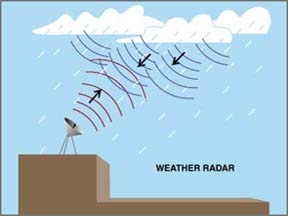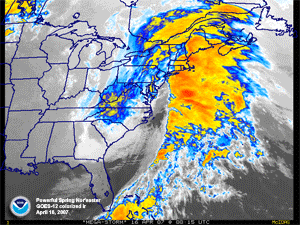This radar was used in a field project run by the National Center for Atmospheric Research in Taiwan.
Click on image for full size
Image courtesy of the University Corporation for Atmospheric Research
How Radar Works
Radar is short for "radio detection and ranging". A transmitter sends pulses of high frequency radio waves. A radar echo shows up on a monitor and shows where the object is located.. A computer measures the time it takes for the signal to reflect off the target and then calculates how far away it is.
One use for radar is in military operations, where it can be used both as an offensive and a defensive weapon. Radar can be used to locate an enemy before an attack, or can warn that an enemy is attacking. Recent advances in stealth technology have proven that radar can be detected and made ineffective.
There are many scientific uses of radar, but the most well-known by the public is weather radar. Weather radar is an important tool in weather forecasting and helps make the forecasts more accurate. Scientists also use radar to study different aspects of the atmosphere, such as wind patterns and air pollution. Radar is also used by space probes such as Magellan to map the surfaces of other planets.
You might also be interested in:

Radar is important to weather forecasters because it can detect rain and hail. The radar bounces radio waves off water particles in clouds. A computer measures how long it takes for the radio waves to
...more
Wind is moving air. Warm air rises, and cool air comes in to take its place. This movement creates different pressures in the atmosphere which creates the winds around the globe. Since the Earth spins,
...more
What do smog, acid rain, carbon monoxide, fossil fuel exhausts, and tropospheric ozone have in common? They are all examples of air pollution. Air pollution is not new. As far back as the 13 th century,
...more
This radar image shows a northeaster that moved through the east coast of the United States on April 15-17, 2007. Several areas in the Mid-Atlantic and northeast regions were flooded because of heavy rain
...more
Some planets are tilted so their North and South Poles are not straight up and down. Earth is tilted a bit - about 23°. Uranus is tilted a lot - more than 90°. Mercury, on the other hand, is hardly tilted
...more
A team of international scientists has completed an aerial survey of part of the East Antarctic Ice Sheet. The survey was done by the Antarctica Gamburstev Province (AGAP) project with the goal of learning
...more
The land in the central United States is the best breeding ground for the storms which produce tornadoes. The land in the Great Plains is relatively flat, which allows cold dry polar air from Canada to
...more















